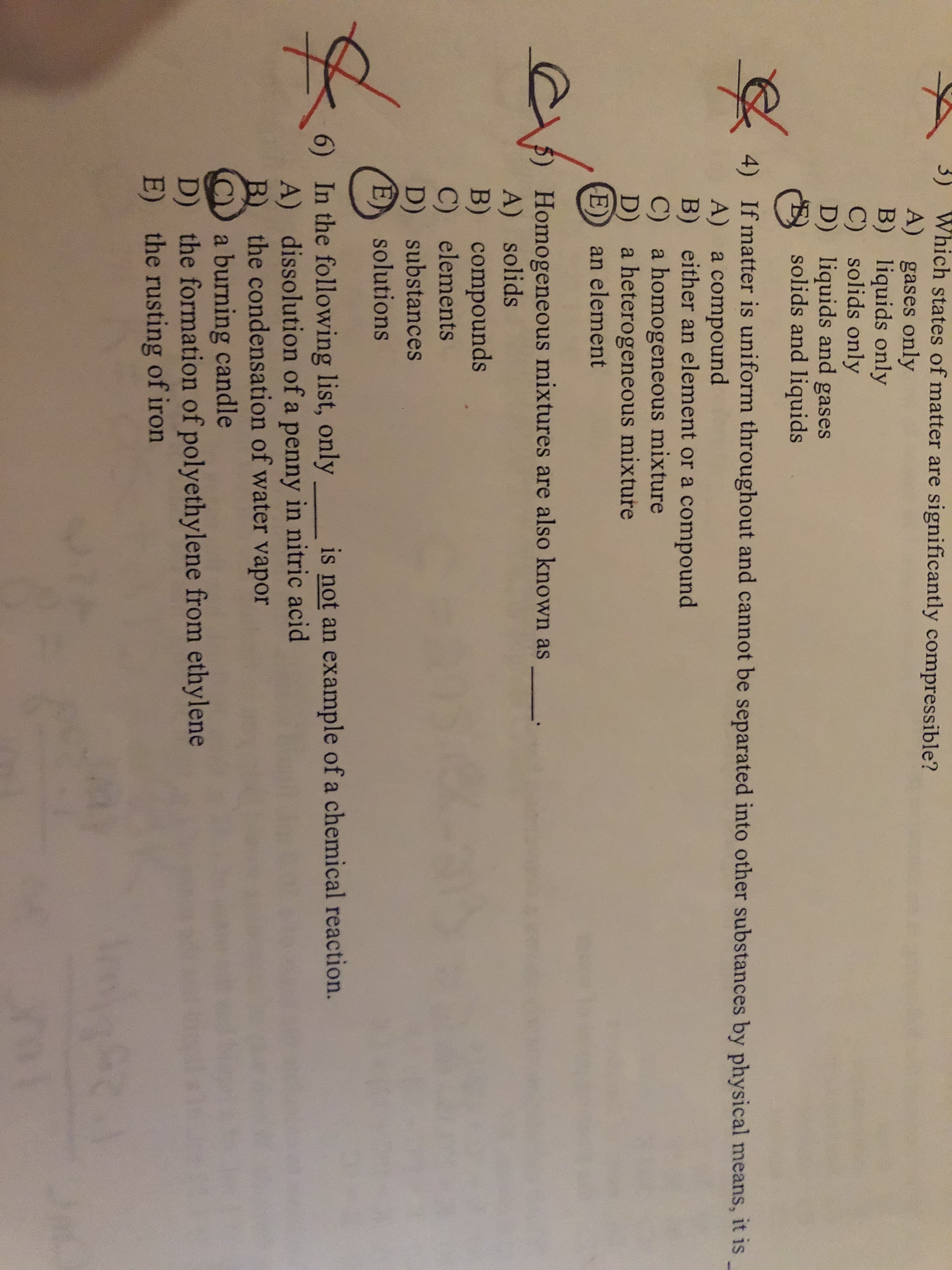3) Which states of matter are significantly compressible? A) gases only B) liquids only C) solids only D) liquids and gases solids and liquids 4) If matter is uniform throughout and cannot be separated into other substances by physical means, it is A) a compound B) either an element or a compound C) a homogeneous mixture D) a heterogeneous mixture E) an element 5) Homogeneous mixtures are also known as A) solids B) compounds C) elements D) substances solutions E) 6) In the following list, only A) dissolution of a penny in nitric acid B) the condensation of water vapor is not an example of a chemical reaction. a burning candle D) the formation of polyethylene from ethylene the rusting of iron E)
3) Which states of matter are significantly compressible? A) gases only B) liquids only C) solids only D) liquids and gases solids and liquids 4) If matter is uniform throughout and cannot be separated into other substances by physical means, it is A) a compound B) either an element or a compound C) a homogeneous mixture D) a heterogeneous mixture E) an element 5) Homogeneous mixtures are also known as A) solids B) compounds C) elements D) substances solutions E) 6) In the following list, only A) dissolution of a penny in nitric acid B) the condensation of water vapor is not an example of a chemical reaction. a burning candle D) the formation of polyethylene from ethylene the rusting of iron E)
Introductory Chemistry: An Active Learning Approach
6th Edition
ISBN:9781305079250
Author:Mark S. Cracolice, Ed Peters
Publisher:Mark S. Cracolice, Ed Peters
Chapter2: Matter And Energy
Section: Chapter Questions
Problem 65E: Distinguish precisely and in scientific terms the differences among items in the following groups. a...
Related questions
Question
Question 4

Transcribed Image Text:3) Which states of matter are significantly compressible?
A) gases only
B) liquids only
C) solids only
D) liquids and gases
solids and liquids
4) If matter is uniform throughout and cannot be separated into other substances by physical means, it is
A) a compound
B) either an element or a compound
C) a homogeneous mixture
D) a heterogeneous mixture
E)
an element
5) Homogeneous mixtures are also known as
A) solids
B) compounds
C) elements
D) substances
solutions
E)
6) In the following list, only
A) dissolution of a penny in nitric acid
B) the condensation of water vapor
is not an example of a chemical reaction.
a burning candle
D) the formation of polyethylene from ethylene
the rusting of iron
E)
Expert Solution
This question has been solved!
Explore an expertly crafted, step-by-step solution for a thorough understanding of key concepts.
This is a popular solution!
Trending now
This is a popular solution!
Step by step
Solved in 3 steps

Knowledge Booster
Learn more about
Need a deep-dive on the concept behind this application? Look no further. Learn more about this topic, chemistry and related others by exploring similar questions and additional content below.Recommended textbooks for you

Introductory Chemistry: An Active Learning Approa…
Chemistry
ISBN:
9781305079250
Author:
Mark S. Cracolice, Ed Peters
Publisher:
Cengage Learning

World of Chemistry, 3rd edition
Chemistry
ISBN:
9781133109655
Author:
Steven S. Zumdahl, Susan L. Zumdahl, Donald J. DeCoste
Publisher:
Brooks / Cole / Cengage Learning

Chemistry for Today: General, Organic, and Bioche…
Chemistry
ISBN:
9781305960060
Author:
Spencer L. Seager, Michael R. Slabaugh, Maren S. Hansen
Publisher:
Cengage Learning

Introductory Chemistry: An Active Learning Approa…
Chemistry
ISBN:
9781305079250
Author:
Mark S. Cracolice, Ed Peters
Publisher:
Cengage Learning

World of Chemistry, 3rd edition
Chemistry
ISBN:
9781133109655
Author:
Steven S. Zumdahl, Susan L. Zumdahl, Donald J. DeCoste
Publisher:
Brooks / Cole / Cengage Learning

Chemistry for Today: General, Organic, and Bioche…
Chemistry
ISBN:
9781305960060
Author:
Spencer L. Seager, Michael R. Slabaugh, Maren S. Hansen
Publisher:
Cengage Learning


Introductory Chemistry: A Foundation
Chemistry
ISBN:
9781337399425
Author:
Steven S. Zumdahl, Donald J. DeCoste
Publisher:
Cengage Learning

Chemistry
Chemistry
ISBN:
9781305957404
Author:
Steven S. Zumdahl, Susan A. Zumdahl, Donald J. DeCoste
Publisher:
Cengage Learning